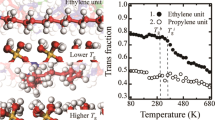Abstract
While poly(1,3,5-trimethyl-1,3,5-trivinyl cyclotrisiloxane, pV3D3) is a promising dielectric material, synthesized from an iCVD process, the physical properties of pV3D3 film have yet to be studied in detail. In this study, the thermoelastic properties of pV3D3 are investigated by molecular dynamics simulations. An amorphous molecular unit cell of pV3D3 is modeled with periodic boundary conditions. The PCFF force field is applied to describe all the inter- and intramolecular interactions. Through classical ensemble simulations, the mechanical properties including the stress-strain curves in tension and compression are determined. The glass transition temperature and the coefficient of thermal expansion are determined from the simulation of cooling-down from an elevated temperature. The simulation results show that the pV3D3 is in an almost rubbery state near room temperature. Moreover, a clear hydrostatic pressure effect is observed in the compressive loading condition of pV3D3 and its elastic modulus is within the range of typical thermoplastic.
Similar content being viewed by others
References
D. Miorandi, S. Sicari, F. D. Pellegrini and I. Chlamtac, Internet of things: Vision, applications and research challenges, Ad Hoc Networks, 10 (7) (2012) 1497–1516.
H. Sundmaeker, P. Guillemin, P. Friess and S. Woelfflé, Vision and Challenges for Realising the Internet of Things, CERP-IOT, Publications Office of the European Union, Luxemburg (2010).
S. M. Sze and K. K. Ng, Physics of semiconductor devices, Third Ed., John Wiley & Sons, INC., New Jersey, USA (2006).
S. R. Forrest, The path to ubiquitous and low-cost organic electronic appliances on plastic, Nature, 428 (2004) 911–918.
C. Reese, M. Roberts, M. M. Ling and Z. Bao, Organic thin film transistors, Materials Today, 7 (9) (2004) 20–27.
A. Facchetti, M. H. Yoon and T. J. Marks, Gate dielectrics for organic field-effect transistros: New opportunities for organic electronics, Advanced Materials, 17 (14) (2005) 1705–1725.
H. Moon, H. Seong, W. C. Shin, W. T. Park, M. Kim, S. Lee, J. H. Bong, Y. Y. Noh, B. J. Cho, S. Yoo and S. G. Im, Synthesis of ultrathin polymer insulating layers by initiated chemical vapor deposition for low-power soft electronics, Nature Materials, 14 (2015) 628–635.
K. K. S. Lau and K. K. Gleason, Initiated chemical vapor deposition (iCVD) of poly(alkyl acrylates): A kinetic model, Macromolecules, 39 (10) (2006) 3695–3703.
M. Gupta and K. K. Gleason, Initiated chemical vapor deposition of poly(1H,1H,2H,2H-perfluorodecyl acrylate) thin films, Langmuir, 22 (24) (2006) 10047–10052.
J. A. Rogers, T. Someya and Y. Huang, Materials and mechanics for stretchable electronics, Science, 327 (5973) (2010) 1603–1607.
B. C. Jang, S. Y. Yang, H. J. Seong, S. K. Kim, J. H. Choi, S. G. Im and S. Y. Choi, Zero-static-power nonvolatile logic-in-memory circuits for flexible electronics, Nano Research, 10 (7) (2017) 2459–2470.
K. Pak, H. Seong, J. Choi, W. S. Hwang and S. G. Im, Synthesis of ultrathin, homogeneous copolymer dielectric to control the threshold voltage of organic thin-film transistors, Advanced Functional Materials, 26 (36) (2016) 6574–6582.
Accelrys Inc., San Francisco, Available from: http://accelrys. com.
The experimental data can be found from Gelest Safety data sheet, 1,3,5-Trivinyl-1,3,5-Trimethyl Cyclotrisiloxane, 1 (2014).
H. Sun, COMPASS: An ab initio force-field optimized for condensed-phase applications-overview with details on alkane and benzene compounds, Journal of Physical Chemistry B, 102 (38) (1998) 7338–7364.
H. B. Fan and M. M. F. Yuen, Material properties of the cross-linked epoxy resin compound predicted by molecular dynamics simulation, Polymer, 48 (7) (2007) 2174–2178.
R. R. Patel, R. Mohanraj and C. U. Pittman Jr., Properties of polystyrene and polymethyl methacrylate copolymers of polyhedral oligomeric silsesquioxanes: A molecular dynamics study, Journal of Polymer Science Part.B: Polymer Physics, 44 (1) (2006) 234–248.
W. G. Hoover, Canonical dynamics: equilibrium phasespace distributions, Physical Review A, 31 (3) (1985) 1695–1697.
W. G. Hoover, Constant-pressure equations of motion, Physical Review A, 34 (3) (1986) 2499–2500.
J. Moon, S. Yang and M. Cho, Interfacial strengthening between graphene and polymer through stone-thrower-Wales defects: Ab initio and molecular dynamics simulations, Carbon, 118 (2017) 66–77.
B. Kim, J. Choi, S. Yang, S. Yu and M. Cho, Multiscale modeling of interphase in crosslinked epoxy nanocomposites, Composites Part B: Engineering, 120 (2017) 128–142.
H. Shin, S. Chang, S. Yang, B. D. Youn and M. Cho, Statistical multiscale homogenization approach for analyzing polymer nanocomposites that include model inherent uncertainties of molecular dynamics simulations, Composites Part B: Engineering, 87 (2016) 120–131.
S. Plimpton, Fast parallel algorithms for short-range molecular dynamics, Journal of Computational Physics, 117 (1) (1995) 1–19.
J. Choi, S. Yu, S. Yang and M. Cho, The glass transition and thermoelastic behavior of epoxy-based nanocomposites: A molecular dynamics study, Polymer, 52 (22) (2011) 5197–5203.
H. F. Mark, Encyclopedia of polymer science and technology, Fourth Ed., John Wiley & Sons, INC., New Jersey, USA (2014).
D. Yoon, Y. W. Son and H. Cheong, Negative thermal expansion coefficient of graphene measured by raman spectroscopy, Nano Letters, 11 (8) (2011) 3227–3231.
J. W. Jiang, J. S. Wang and B. Li, Thermal expansion in single-walled carbon nanotubes and graphene: Nonequilibrium Green’s function approach, Physical Review B, 80 (20) (2009) 205429.
Author information
Authors and Affiliations
Corresponding author
Additional information
Recommended by Associate Editor Heung Soo Kim
Sunyong Kwon received bachelor degree of engineering and chemistry at Chung-Ang University, Korea in 2017. She is currently a master degree student of the graduate school of engineering at Chung-Ang University. Her research interests are molecular modeling of multifunctional nanocomposites for long time durability.
Seunghwa Yang is an Assistant Professor at Chung-Ang University, Seoul, Korea, since 2015. He received doctoral degree of mechanical engineering at Seoul National University in 2011. His major research fields are atomistic modeling of soft materials, sequential multiscale modeling of multifunctional composites, nanocarbon defect engineering, and micromechanics.
Rights and permissions
About this article
Cite this article
Yang, S., Yoon, S. & Kwon, S. Atomistic molecular dynamics simulation study on thermomechanical properties of poly(1,3,5-trimethyl-1,3,5-trivinyl cyclotrisiloxane) dielectric insulator for soft electronics. J Mech Sci Technol 32, 2183–2189 (2018). https://doi.org/10.1007/s12206-018-0427-y
Received:
Revised:
Accepted:
Published:
Issue Date:
DOI: https://doi.org/10.1007/s12206-018-0427-y




